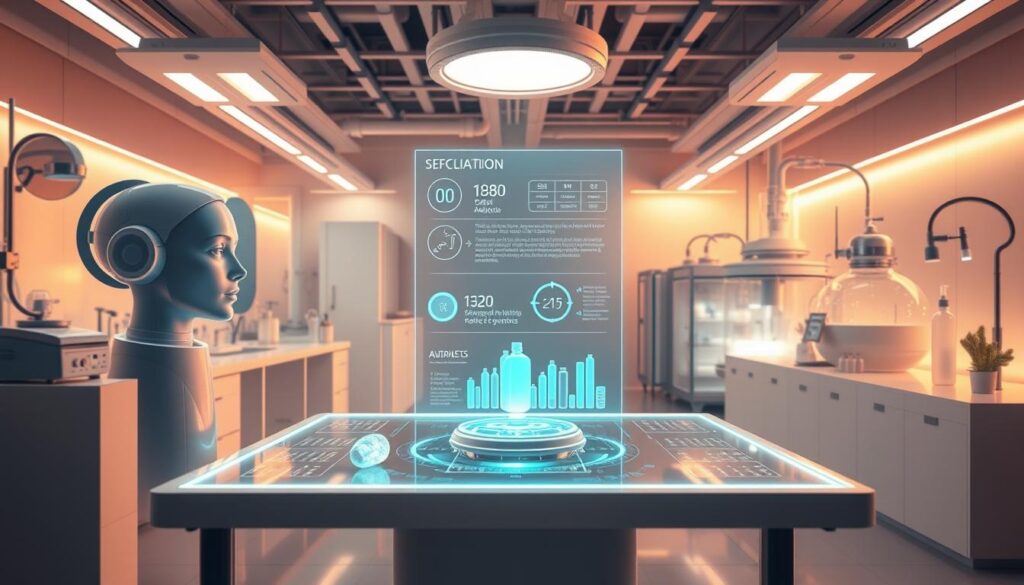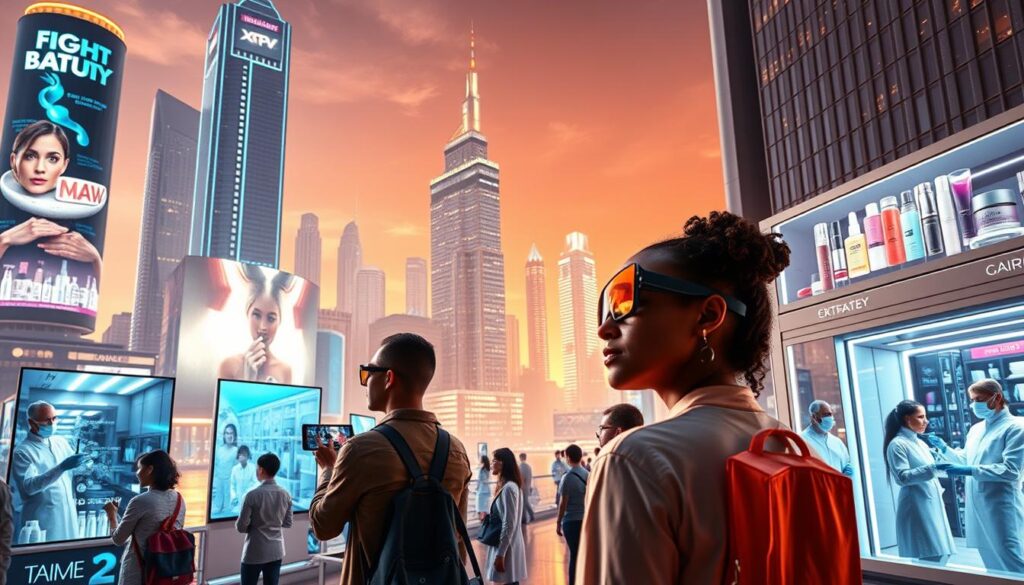Did you know that 67% of consumers now prefer cruelty-free and vegan skincare products? This shift is driving the demand for innovative ingredients like lab-grown collagen and hyaluronic acid, which are not only effective but also sustainable1. By 2025, the beauty industry is expected to see a 10.2% annual growth in biotechnology-driven solutions, reshaping how we care for our skin1.
Lab-grown ingredients are revolutionizing the industry by reducing the carbon footprint by up to 50% compared to traditional methods1. These advancements are not just about sustainability; they also enhance product efficacy by up to 30%, offering better results for your skin1. With 75% of brands adopting sustainable practices by 2025, the future of skincare is both eco-friendly and highly effective1.
Consumers are increasingly seeking products that are transparently labeled and tailored to their needs. This trend is pushing brands to innovate and deliver solutions that combine science, sustainability, and personalization. The convergence of technology and nature is creating a new era of skincare that prioritizes both your health and the planet.
Key Takeaways
- 67% of consumers prefer cruelty-free and vegan skincare products1.
- Lab-grown ingredients reduce the carbon footprint by up to 50%1.
- Biotech-driven solutions enhance product efficacy by 30%1.
- 75% of beauty brands will adopt sustainable practices by 20251.
- Transparency and personalization are key consumer demands.
Introduction to 2025’s Skincare Revolution
The skincare landscape is evolving faster than ever, driven by new demands and innovations. Consumers are no longer satisfied with complex routines. They want fewer, more effective products that deliver visible results. This shift is reshaping the industry, pushing brands to rethink their approach to formulations and packaging2.
Understanding Shifting Consumer Demands
Today’s consumers are smarter and more informed. They seek transparency and simplicity in their skincare routines. 70% of skincare users prefer products with scientifically-backed ingredients, such as lab-grown alternatives3. This demand is driving brands to focus on high-efficacy formulations that address specific concerns like barrier repair and hydration.
Personalization is another key trend. 45% of consumers are willing to pay more for tailored solutions that match their unique skin type and needs3. This has led to the rise of AI-powered diagnostics, which analyze your skin and recommend the best products for you.
Environmental and Technological Impacts
Environmental concerns are also shaping the future of skincare. Brands are adopting eco-friendly practices, from sustainable packaging to energy-efficient production techniques. Green biotechnology is reducing waste and lowering energy usage by up to 30%4.
Technology is playing a crucial role too. AI algorithms are speeding up the development of new ingredients, cutting testing time by 40%4. This innovation ensures that products are not only effective but also ethically produced. The result is a skincare industry that’s smarter, greener, and more inclusive than ever before.
Transformative Trends in Biotech Beauty
The future of skincare is being reshaped by groundbreaking innovations in biotechnology. These advancements are not only meeting consumer demands for effective solutions but also addressing environmental concerns. By 2025, the industry will see a significant shift toward sustainable, science-backed products that deliver visible results5.
Innovative Lab-Grown Ingredients
Lab-grown ingredients are emerging as sustainable alternatives to traditional actives. These ingredients reduce the environmental impact of production while maintaining high efficacy. For example, lab-grown hyaluronic acid offers the same hydrating benefits as its traditional counterpart but with a smaller carbon footprint6.
Consumers are increasingly drawn to these innovations because they align with their values. Over 70% of skincare users prefer products with scientifically-backed ingredients. This trend is pushing brands to adopt greener practices and focus on ingredient transparency.
Designer Peptides and Their Benefits
Designer peptides are another game-changer in the skincare industry. These advanced formulations are designed to target specific skin concerns, such as barrier repair and hydration. Peptides like benthi plant peptide stimulate natural collagen production, offering anti-aging benefits without animal sources6.
These peptides not only enhance skin health but also reduce the need for multiple products. By focusing on targeted treatments, consumers can simplify their routines while achieving better results. This approach is particularly appealing to those seeking personalized skincare solutions.
| Ingredient | Benefit | Environmental Impact |
|---|---|---|
| Lab-Grown Hyaluronic Acid | Deep hydration | Reduced carbon footprint |
| Benthi Plant Peptide | Collagen stimulation | Animal-free production |
| Fermented Botanicals | Skin barrier repair | Lower energy usage |
As the beauty industry evolves, these biotech-driven trends are setting new standards. They combine innovation, sustainability, and efficacy to meet the needs of today’s informed consumers. The result is a skincare landscape that’s both effective and eco-conscious.
Spotlight: Biotech Beauty: Lab-Grown Collagen & Peptides Redefining Skincare in 2025
The beauty industry is witnessing a groundbreaking shift as lab-grown collagen and peptides take center stage in skincare formulations. These ingredients are developed using advanced research methods, ensuring high efficacy and sustainability7. By 2025, they are expected to become mainstream, replacing traditional animal and plant sources7.
These innovations are not just about performance; they also address environmental concerns. Lab-grown ingredients reduce the carbon footprint by up to 50% compared to conventional methods7. This aligns with the growing consumer demand for eco-friendly products that deliver visible results.
Clinical studies have shown that lab-grown collagen and peptides enhance skin health by improving hydration and barrier repair8. Experts in the industry endorse these formulations for their ability to target specific concerns like aging and sensitivity. Consumers are increasingly drawn to these solutions because they combine science, sustainability, and efficacy.
Brands are also focusing on transparency, clearly labeling their products to meet consumer expectations. This approach builds trust and ensures that you know exactly what you’re applying to your skin. The shift toward clean, effective formulations is setting new benchmarks in the industry.
As the beauty industry evolves, these biotech-driven trends are reshaping how we care for our skin. They offer a sustainable, effective alternative that meets the needs of today’s informed consumers. The future of skincare is here, and it’s smarter, greener, and more inclusive than ever before.
AI-Driven Personalization and Skincare Technology
Artificial intelligence is transforming how we approach skincare, offering personalized solutions tailored to your unique needs. From smart diagnostics to custom recommendations, AI is reshaping the way brands develop and deliver products. This technology ensures that your skincare routine is not only effective but also aligned with your specific concerns and goals.
Smart Diagnostics and Custom Recommendations
AI-powered apps and devices are revolutionizing how you understand your skin. Tools like Neutrogena’s Skin360 app analyze your skin’s hydration, texture, and pigmentation to generate over 2.5 million possible product recommendations9. This level of precision ensures that you receive tailored solutions for issues like dryness, sensitivity, or aging.
Brands like Shiseido are also leveraging AI to analyze 80,000 skin patterns, offering personalized formulations that address your unique needs9. These innovations simplify your routine while delivering visible results, making skincare more accessible and effective than ever before.
Leveraging AI for Ingredient Research
AI is also accelerating the discovery of new ingredients and formulations. Platforms like BASF’s D’lite help identify sustainable alternatives, reducing the environmental impact of production10. This technology ensures that your products are not only effective but also eco-friendly.
Metanovas Biotech is using AI to design personalized peptides that target specific skin conditions, such as inflammation and barrier repair10. This approach enhances product efficacy while reducing development time, ensuring that you receive cutting-edge solutions faster.
- AI-powered diagnostics analyze your skin to provide tailored recommendations10.
- Custom formulations address specific concerns like dryness and sensitivity9.
- AI accelerates ingredient discovery, reducing production time and environmental impact10.
With AI-driven technology, the future of skincare is personalized, efficient, and sustainable. These innovations ensure that your routine meets your needs while aligning with your values.
Sustainability and Waterless Skincare Innovations
Sustainability is no longer just a buzzword in the beauty industry; it’s a driving force behind innovation. Consumers are increasingly seeking products that align with their values, pushing brands to adopt eco-friendly practices. This shift is reshaping how skincare is developed, packaged, and consumed11.
Eco-Friendly Packaging Solutions
Packaging plays a crucial role in reducing the environmental impact of skincare products. Brands are now turning to biodegradable, refillable, and recyclable materials to meet consumer demands. For example, Gezeiten’s refillable face cream jar won the iF DESIGN AWARD 2023, showcasing how design and sustainability can go hand in hand11.
Recycled content is also gaining traction, with new regulations promoting the use of waste materials like fabric scraps from the fashion industry11. These innovations not only reduce waste but also enhance the overall user experience.
Concentrated, Waterless Formulations
Waterless skincare is another trend gaining momentum. By eliminating water from formulations, brands can create more concentrated products that require fewer preservatives. This approach reduces the carbon footprint and enhances product efficacy12.
Formats like solid bars and dissolvable tablets are becoming popular. Onélogy’s Megadose serum, for instance, features a dissolvable tablet format that minimizes waste while delivering maximum potency11. These innovations cater to the growing demand for sustainable and effective solutions.
“Sustainability is not just about reducing waste; it’s about creating products that are both effective and environmentally responsible.”
| Packaging Material | Benefits | Examples |
|---|---|---|
| Biodegradable | Reduces landfill waste | Gezeiten’s refillable jar |
| Recycled Content | Utilizes waste materials | Fabric waste from fashion |
| Refillable | Minimizes packaging waste | Morrama/PPK’s refillable range |
These advancements are not just good for the planet; they also meet the needs of today’s informed consumers. By prioritizing sustainability, brands can build trust and loyalty while contributing to a greener future12.
Redefining Skin Barrier Repair and Health
Your skin’s barrier is its first line of defense against environmental stressors. When it’s compromised, issues like dryness, sensitivity, and irritation can arise. That’s why maintaining a healthy barrier is essential for long-term skin wellness. Today, brands are focusing on advanced ingredients that repair and protect this crucial layer, ensuring your skin stays resilient and glowing13.
Advanced Ingredients for Barrier Repair
Modern skincare products are packed with cutting-edge ingredients designed to strengthen your skin barrier. Ceramides, for example, replenish lipids that lock in moisture and prevent water loss. Niacinamide reduces redness and improves elasticity, while peptides stimulate collagen production for firmer skin14.
These ingredients not only repair damage but also protect against future issues. Clinical studies show that formulations with ceramides and peptides improve barrier function by up to 30%, offering long-lasting results13. This innovation meets the growing consumer demand for effective, science-backed solutions.
Benefits of Probiotics and Postbiotics
Probiotics and postbiotics are emerging as game-changers in skincare. These ingredients support a healthy microbiome, reducing inflammation and promoting balance. Probiotics strengthen the skin’s natural defenses, while postbiotics soothe irritation and enhance repair14.
Brands are incorporating these actives into serums, creams, and masks to address concerns like sensitivity and acne. Research shows that products with probiotics can reduce inflammation by 30%, making them a must-have for anyone with reactive skin14.
“A healthy skin barrier is the foundation of radiant, resilient skin. Advanced ingredients like probiotics and ceramides are transforming how we care for our skin.”
- Ceramides and peptides restore barrier function by up to 30%13.
- Probiotics reduce inflammation and support a balanced microbiome14.
- Postbiotics soothe irritation and enhance repair14.
These innovations are reshaping the skincare industry, offering solutions that prioritize both health and efficacy. By focusing on barrier repair, brands are meeting the needs of today’s informed consumers, ensuring your skin stays healthy and radiant13.
Simplifying Routines with Skinimalism
In 2025, skincare routines are becoming simpler and more efficient, thanks to the rise of skinimalism. This trend focuses on using fewer products that deliver multiple benefits, reducing clutter and saving time15. Consumers are increasingly drawn to this approach, as it aligns with their desire for simplicity and high-impact results16.
Multi-Functional Product Innovations
Multi-functional products are at the heart of skinimalism. These formulations combine several steps into one, offering benefits like hydration, sun protection, and anti-aging15. For example, tinted moisturizers with SPF or serums infused with peptides and niacinamide are gaining popularity17.
This innovation not only simplifies your routine but also reduces ingredient overload. By focusing on targeted formulations, you can achieve better results with fewer products16. This approach also supports sustainability by minimizing packaging waste17.
The Rise of Minimalist Beauty
Minimalist beauty is more than a trend; it’s a lifestyle shift. Consumers are prioritizing efficiency and effectiveness, opting for products that address multiple concerns at once15. This aligns with the growing demand for transparency and sustainability in the beauty industry16.
Brands are responding by creating formulations that integrate science and nature. For instance, hybrid products like moisturizers with actives or serums with antioxidants are becoming staples in minimalist routines17. These innovations ensure that your skincare is both effective and eco-friendly.
“Skinimalism is not just about using fewer products; it’s about choosing smarter solutions that work harder for your skin.”
As the beauty industry evolves, skinimalism is setting new standards. It offers a practical, sustainable approach to skincare that meets the needs of today’s informed consumers. By embracing this trend, you can simplify your routine while achieving healthier, more radiant skin15.
Regenerative Treatments and Next-Gen Devices
Regenerative treatments and advanced devices are revolutionizing how we care for our skin, offering professional-level results from the comfort of home. These innovations bridge the gap between spa treatments and everyday routines, making high-efficacy solutions accessible to everyone18.
From PRP (Platelet-Rich Plasma) to NAD+ boosters, these treatments target cellular repair and rejuvenation. For instance, Mibelle Biochemistry’s RejuveNAD technology can make skin appear as much as eight years younger by stimulating the endogenous regeneration of NAD+18. This approach not only enhances skin health but also aligns with the growing demand for sustainable and effective solutions.
At-Home Skincare Technologies
At-home devices like LED masks and microcurrent systems are becoming increasingly popular. These tools offer near-clinical results, allowing you to address concerns like wrinkles and elasticity without frequent spa visits19. For example, Embr Labs’ Embr Wave is a wearable device designed to provide immediate relief from hot flashes, showcasing how technology is merging with personal care18.
These devices are not just convenient; they also empower you to take control of your skincare routine. With advancements in technology, you can now achieve professional-grade results in the comfort of your home20.
Clinical Developments in Skincare
Clinical advancements are bringing office-grade treatments into over-the-counter products. Ingredients like exosomes are recognized for their role in enhancing collagen production and skin rejuvenation19. This innovation ensures that you receive cutting-edge solutions without the need for invasive procedures.
Brands are also integrating plant-based actives like human TIMP2 from LipoTrue, which delays dermochronology caused by photoaging18. These developments highlight the industry’s commitment to combining science and sustainability for better skin health.
| Treatment | Benefit | Example |
|---|---|---|
| PRP | Cellular repair | Platelet-Rich Plasma therapy |
| NAD+ Boosters | Youthful appearance | Mibelle Biochemistry’s RejuveNAD |
| Exosomes | Collagen production | Plant-based human TIMP2 |
These regenerative technologies are setting new standards in the beauty industry, offering solutions that are both effective and accessible. By integrating these innovations into your routine, you can achieve healthier, more radiant skin18.
The Integration of Technology and Personal Wellness
Technology is reshaping personal wellness, offering tools that blend innovation with self-care. From smart mirrors to advanced diagnostic devices, these solutions are transforming how you understand and care for your skin. This integration is not just about aesthetics; it’s about creating a holistic approach to health and well-being21.

Smart Mirrors and Diagnostic Tools
Smart mirrors are leading the way in personalized skincare. These devices use AI to analyze your skin’s hydration, texture, and overall condition in real time22. Brands like Neutrogena and Shiseido are leveraging this technology to provide tailored recommendations, ensuring your routine meets your specific needs23.
Diagnostic tools are also becoming more accessible. DNA kits and skin biological age tests are helping consumers track their progress and make informed decisions22. These innovations empower you to take control of your skincare, offering results that were once only available in professional settings21.
Holistic Approaches to Self-Care
Wellness is no longer just about physical health; it’s about mental and emotional balance too. Brands are integrating aromatherapy, mindfulness tools, and adaptogenic supplements into their products23. This holistic approach ensures that your skincare routine supports your overall well-being21.
For example, products infused with probiotics and postbiotics not only improve your skin barrier but also promote a healthy microbiome22. This dual benefit aligns with the growing demand for solutions that address multiple concerns at once23.
“The future of beauty is not just about looking good; it’s about feeling good too. Technology and wellness are merging to create a more inclusive and effective approach to self-care.”
As the industry evolves, these innovations are setting new standards. They combine cutting-edge technology with a focus on sustainability and inclusivity, ensuring that everyone can benefit from these advancements21.
The Role of Influencers and Community in Shaping Trends
Social media has become a powerful tool for driving skincare trends and consumer choices. Influencers, especially micro-influencers, are now trusted more than traditional endorsements. Their authentic approach resonates with audiences, making them key players in shaping opinions24.
Consumers are increasingly turning to community-driven content for skincare advice. Platforms like Instagram and TikTok have become hubs for sharing product reviews and routines. This shift reflects a broader demand for transparency and relatability in the beauty industry25.
Local influencers are driving authenticity by sharing their personal experiences. For example, a skincare enthusiast in Los Angeles gained traction by reviewing eco-friendly products. Her followers trusted her recommendations, leading to a surge in sales for the brands she endorsed24.
Peer recommendations are now pivotal in trendsetting. When someone in your social circle shares their positive experience with a product, it feels more credible. This word-of-mouth approach is reshaping how brands market their solutions25.
“Influencers are not just promoting products; they’re building trust and fostering communities that value authenticity.”
This trend is empowering consumers to make informed decisions. By relying on real-life experiences, you can find products that truly meet your needs. The future of skincare marketing lies in this community-driven approach, where everyone has a voice24.
Navigating Ingredient Transparency and Ethical Sourcing
Transparency in skincare is no longer optional—it’s a necessity for today’s informed consumers. As you demand cleaner, safer products, brands are stepping up to meet these expectations. This shift is reshaping the industry, focusing on ethical practices and clear labeling26.
Clean, Organic Formulations
Clean beauty is more than a trend; it’s a movement. Consumers are increasingly seeking products free from harmful chemicals and synthetic materials26. Brands are responding with formulations that prioritize natural, organic ingredients like plant-based oils and fermented botanicals27.
These ingredients not only nourish your skin but also align with your values. For example, lab-grown alternatives like hyaluronic acid offer the same benefits as traditional sources but with a smaller environmental footprint26.
Meeting Consumer Demands for Transparency
Transparency is key to building trust. Consumers want to know where their products come from and how they’re made. Brands that clearly label their ingredients and sourcing practices are gaining a competitive edge28.
Regulatory bodies are also playing a role. New guidelines are pushing brands to reformulate products to meet higher safety standards26. This ensures that you’re getting effective, safe solutions for your skin.
“Transparency isn’t just about listing ingredients; it’s about fostering trust and accountability in the beauty industry.”
Ethical sourcing is another critical factor. Brands are adopting practices like upcycling waste materials to create high-value ingredients27. This approach not only reduces environmental impact but also supports sustainability goals.
| Practice | Benefit | Example |
|---|---|---|
| Upcycling | Reduces waste | Kaffe Bueno’s coffee grounds |
| Clear Labeling | Builds trust | Brands like Drunk Elephant |
| Regulatory Compliance | Ensures safety | MoCRA guidelines |
As the industry evolves, transparency and ethical practices are setting new standards. These innovations ensure that your skincare routine is not only effective but also aligned with your values26.
Future Projections for the Beauty Industry in the United States
The U.S. beauty industry is on the brink of significant transformation, driven by economic shifts and evolving consumer preferences. As inflation and rising costs of goods impact production, brands are adapting to meet new challenges while staying competitive29.
Economic and Market Dynamics
Trade tensions and tariffs are reshaping how brands source ingredients and manufacture products. Rising labor costs are also pushing companies to innovate in production methods29. These factors are expected to influence pricing, making affordability a key concern for consumers30.
Despite these challenges, the demand for effective skincare solutions remains strong. Brands are focusing on cost-effective alternatives, such as multi-functional products, to meet consumer needs26.
Anticipating Shifts in Consumer Behavior
Consumers are increasingly prioritizing transparency and affordability. 78% of shoppers are more likely to purchase products with clear ingredient lists29. This trend is driving brands to adopt cleaner formulations and sustainable practices26.
Personalization is another key focus. Advanced AI tools are expected to analyze hydration levels, pore size, and pigmentation, making tailored solutions the new norm by 202529.

Streamlined routines, known as skinimalism, are gaining traction. Consumers are opting for fewer, high-quality products that address multiple concerns without disrupting the skin barrier30.
| Trend | Impact | Example |
|---|---|---|
| Personalization | Tailored solutions | AI-driven diagnostics |
| Sustainability | Eco-friendly practices | Refillable packaging |
| Skinimalism | Simplified routines | Multi-functional serums |
As the industry evolves, brands must balance innovation with affordability. By focusing on transparency, sustainability, and personalization, they can meet the demands of today’s informed consumers26.
Conclusion
The future of personal care is being reshaped by cutting-edge innovations that prioritize both your health and the planet. From AI-driven diagnostics to sustainable formulations, these advancements are transforming how you care for your skin31. Personalized solutions are becoming the norm, ensuring your routine meets your unique needs12.
Transparency and sustainability are at the forefront of this evolution. Brands are adopting eco-friendly practices, from clean ingredient lists to refillable packaging31. This shift not only benefits the environment but also aligns with your values as a consumer12.
Streamlined routines are another key trend, offering multi-functional products that save time and deliver visible results31. These innovations ensure your skin stays healthy and radiant without unnecessary steps12.
Stay informed about these exciting developments to make the most of your personal care routine. The future is bright, with innovations that combine science, sustainability, and efficacy for long-term results.
FAQ
What makes lab-grown ingredients different from traditional ones?
How do designer peptides benefit my skin?
Can AI really personalize my skincare routine?
What are waterless skincare formulations?
How do probiotics and postbiotics help with skin barrier repair?
What is skinimalism, and why is it trending?
Are at-home skincare devices as effective as professional treatments?
How do smart mirrors and diagnostic tools improve skincare?
Why is ingredient transparency important in skincare?
What trends are shaping the future of the beauty industry?
Source Links
- Efficacy Meets Ethics: Why Biotech Beauty is the Next Big Thing – https://www.deverauxspecialties.com/the-latest-buzz/efficacy-meets-ethics-why-biotech-beauty-is-the-next-big-thing/
- Innovate or Die: A Q&A with Mintel Beauty and Personal Care Global President Jane Henderson – https://www.gcimagazine.com/ingredients/article/21849338/innovate-or-die-a-qa-with-mintel-beauty-and-personal-care-global-president-jane-henderson
- Beauty Beyond The Knife – https://beautybeyondtheknife.com/
- Beauty’s Biotech Boom: Unveiling 2025’s Cosmetic Marvels – https://reads.alibaba.com/beautys-biotech-boom-unveiling-cosmetic-marvels/
- Council Post: Beauty Innovations: 5 Trends Redefining The Consumer Experience – https://www.forbes.com/councils/forbesbusinesscouncil/2025/01/23/beauty-innovations-5-trends-redefining-the-consumer-experience/
- 10 Beauty Trends for 2025 That Will Revolutionise Your Routine (and Help the Planet) – Twelve Beauty – https://www.twelvebeauty.com/10-beauty-trends-for-2025/
- What’s Next in Beauty? The Top 6 Skincare Trends For 2025 – https://appleandbears.com/blogs/news/top-6-skincare-trends-for-2025?srsltid=AfmBOoqm9Q0y7Zyxa2-KYKZOZyWPyxKGG_o9Wx-XIjapAkqMowaPdKRL
- 90 Beauty Innovations that Made the Cut: C&T Reveals the 2025 Allēs Finalists – https://www.cosmeticsandtoiletries.com/news/event-coverage/news/22925734/ct-alle-awards-2025-90-beauty-innovations-that-made-the-cut-ct-reveals-the-2025-alls-finalists
- 9 New Skin Care Rules – https://www.gcimagazine.com/brands-products/skin-care/article/21848981/mibelle-ag-biochemistry-9-new-skin-care-rules
- Digital Tech in Beauty: Ingredient Discovery, Early Trend Spotting, Personalization, Digital Collabs, Molecular Design and More – https://www.cosmeticsandtoiletries.com/research/consumers-market/article/22922396/digital-tech-in-beauty-ingredient-discovery-early-trend-spotting-personalization-digital-collabs-molecular-design-and-more
- Sustainable Beauty Innovations – Packaging & Formulations (EN) – https://re-sources.co/sustainable-beauty-innovations-packaging-formulations-2023/
- Skincare Formulation Trends to Watch in 2025 | Clean Beauty India – https://cleanbeautyindia.in/skincare-formulation-trends-to-watch-in-2025/
- What’s Next in Beauty? The Top 6 Skincare Trends For 2025 – https://appleandbears.com/ko/blogs/news/top-6-skincare-trends-for-2025?srsltid=AfmBOopJeNInb1OThzlRvboVFi-wi-L-3bDOPkJtlNQXfLLJAezGn70T
- Innovations in Private Labeling Skincare that are Shaping the Future of Cosmetic – https://medpaksolutions.com/private-label-skincare-top-innovations/
- Top 5 Skincare Trends in Europe for February 2025 – https://www.skindoctor.ai/post/top-5-skincare-trends-in-europe-for-february-2025
- 8 Beauty Trends To Watch Out For In 2025 – https://fashionpoliceng.com/beauty/beauty-trends-in-2025/
- How To Formulate Multi-Functional Organic Skincare Products – https://learncanyon.com/multi-functional-organic-skincare-products/
- The Beautyspan: Biohacking Longevity – https://www.gcimagazine.com/ingredients/launches-claims/article/22885333/the-beautyspan-biohacking-longevity
- Top 15 Beauty Predictions for 2025: Insider Insights – https://www.gcimagazine.com/consumers-markets/article/22922822/top-15-beauty-predictions-for-2025-insider-insights
- Formulating Demographic Beauty – From Boomers to Generation Alpha – https://www.cosmeticsandtoiletries.com/research/consumers-market/article/22929474/formulating-demographic-beauty-from-boomers-to-generation-alpha
- Skincare Trends Soaring—And Sinking—In 2025 – https://www.beautyindependent.com/skincare-trends-soaring-2025/
- How Longevity is Shaping Beauty & Wellness – INNOCOS – https://innocosevents.com/10-beauty-and-wellness-trends-to-watch-in-2025/
- Macro & Micro Beauty Trend Predictions 2025 – https://www.happi.com/exclusives/macro-micro-beauty-trend-predictions-2025/
- Top Cosmetic Formulation Trends in 2024: Innovations Shaping the Future of Beauty – https://www.linkedin.com/pulse/top-cosmetic-formulation-trends-2024-innovations-shaping-sawarkar-1hmpf
- trends — Forecasting and Consulting in Beauty Innovation – https://www.inspiration-creation.com/cosmeticseeds-blog/category/trends
- Clean Beauty in 2025: What Ingredients Are Taking Over? – https://www.halecosmeceuticals.com/blog/clean-beauty-in-2025-what-ingredients-are-taking-over
- Discover the top 3 sustainability trends that will define beauty in 2025 – https://thinkb2bmarketing.com/top-3-sustainability-trends-that-will-define-beauty-in-2025/
- Stagnation Or Evolution?: The Fierce Debate Over Beauty’s Sputtering Ingredient Innovation – https://www.beautyindependent.com/stagnation-evolution-great-debate-beauty-sputtering-ingredient-innovation/
- Future-Forward Beauty: Top Skincare Trends to Watch in 2025 – The Skincare Whisperer – https://theskincarewhisperer.com/future-forward-beauty-top-skincare-trends-to-watch-in-2025/
- Global Beauty Trends That Will Make Waves in 2025 – https://stylespeak.com/trends/hair-beauty-trends/global-beauty-trends-that-will-make-waves-in-2025/
- How The Skin Lab Blends Tradition with Innovation – Dermaplane – https://www.dermaplane.co/skin-lab/




